Mechanical Strength Characterization of Plastic Fiber Reinforced Cement Concrete Composites
Abstract
:Featured Application
Abstract
1. Introduction
Problem Statement
2. Materials and Methods
2.1. Materials and Properties
2.2. Plastic Fibers
2.3. Fresh Concrete Design
2.4. Concrete Production
2.5. Experimental Methodology and Testing
2.6. Experimental Testing
2.6.1. Compressive Test Measurements
- (a)
- Ultimate compressive strength—maximum peak strength of concrete.
- (b)
- Residual strength—concrete specimens loaded at 95% of ultimate load and unloaded completely; then reloaded till failure to obtain the residual strength.
- (c)
- Elastic modulus—the ratio of stress–strain value obtained from stress-strain plot.
- (d)
- Pre-peak strain hardening toughness—the area under the stress-strain plot until the ultimate stress.
- (e)
- Absolute toughness—the entire area under the stress-strain plot until failure of concrete.
- (f)
- Post ultimate compressive toughness—the area under the stress-strain plot between the ultimate stress and complete failure.
- (g)
- Compressive strength increase—the ratio of compressive strength of reference concrete to that of fiber incorporated concrete mixes.
- (h)
- Compressive toughness increase—the ratio of absolute toughness of reference concrete (RCM-30) to that of plastic fiber concretes.
- (i)
- Fiber performance index—the sum of compressive strength and absolute toughness increase of plastic fiber concretes to that of reference concrete.
2.6.2. Flexural Test Measurements
- (a)
- First crack strength—the strength of concrete beam specimens at the first visible crack during loading.
- (b)
- Flexural strength—the maximum ultimate strength of concrete beam.
- (c)
- Crack width—the maximum crack opening at complete failure.
- (d)
- Residual flexural strength capacity—concrete specimens loaded at 95% of ultimate flexural load and unloaded completely; then reloaded until failure.
- (e)
- Flexural toughness—area under the entire load—CMOD curves obtained from the various fiber concrete mixes.
- (f)
- Post-peak drop load resistance—the sudden drop in load carrying capacity of the beam after the peak load.
- (g)
- Flexural strength increase—the ratio of absolute toughness of reference concrete (RCM-30) to plastic fiber concretes.
- (h)
- Fiber effective index—the sum of flexural strength increase and absolute toughness of plastic fiber concretes to that of reference concrete.
3. Results
3.1. Compressive Strength Evaluation
3.2. Ultimate Compressive Strength
3.3. Residual Compressive Strength
3.4. Elastic Modulus
3.5. Pre-Peak Strain Hardening Toughness
3.6. Absolute Toughness
3.7. Post-Ultimate Compressive Toughness
3.8. Compressive Strength Increase
3.9. Compressive Toughness Increase
3.10. Fiber Performance Index
3.11. Flexural Characteristics
3.12. First Crack Strength
3.13. Flexural Strength
3.14. Crack Width
3.15. Residual Flexural Strength Capacity
3.16. Flexural Toughness
3.17. Post-Peak Drop Load Resistance
3.18. Fiber Effective Index
4. Discussion
5. Conclusions
- (a)
- Stress-strain characteristics of fiber incorporated concretes up to 0.15% Vf in compression were appreciably improved with a higher compressive strength of 33.20 N/mm2 and post-peak compressive toughness of 357.75 N-m.
- (b)
- Maximum absolute toughness of 516.38 N-m was reported in the case of plastic fiber substituted concrete mixes (PFC-10H) with a toughness increase up to 321%.
- (c)
- Compressive failure modes were typically controlled with visible multiple cracks on the surface. Post-peak toughness of concrete showed controlled deformation without sudden failure due to composite ductility of plastic fibers in the matrix.
- (d)
- Flexural evaluations of plastic fiber incorporated concrete mixes placed either homogenously or tension zone confined concretes were beneficial in improving the bending properties of concrete. However, the effective fibers placed in the tension zone appreciably contributed to the overall increase in the flexural parameters. Plastic fiber incorporation at 0.15% Vf in concrete mixes resulted in maximum flexural toughness of 33.43 N-m and maximum residual strength of 4.37 N/mm2.
- (e)
- All the flexural test properties were consistently increased when the total fiber volume was confined in the tension zone due to the effective load sharing capability of fibers as well as the maximum fiber availability. Plastic fibers control the sudden growth of cracking inside the matrix before reaching the ultimate load, thereby exhibiting an improved post-crack toughness.
- (f)
- The optimal plastic fiber volume (0.10% Vf) is promising in contributing to the fiber reinforcing efficiency in the matrix and crack bridging mechanism, providing maximum stress carrying capacity. Maximum flexural strength (5.26 N/mm2) and post peak drop load resistance (96%) were obtained in the tension zone confined concrete compared to full depth homogenous fiber reinforced concretes.
Author Contributions
Funding
Data Availability Statement
Acknowledgments
Conflicts of Interest
References
- Siddique, R.; Khatib, J.; Kaur, I. Use of recycled plastic in concrete: A review. Waste Manag. 2007, 28, 1835–1852. [Google Scholar] [CrossRef] [PubMed]
- Zhao, K.; Chen, W.; Yang, D.; Zhao, W.; Wang, S.; Song, W. Mechanical tests and engineering applicability of fibre plastic concrete used in tunnel design in active fault zones. Tunn. Undergr. Space Technol. J. 2019, 88, 200–208. [Google Scholar] [CrossRef]
- Khalid, F.S.; Irwan, J.M.; Ibrahim, M.W.; Othman, N.; Shahidan, S. Performance of plastic wastes in fiber reinforced concrete beams. Constr. Build. Mater. J. 2018, 183, 451–464. [Google Scholar] [CrossRef]
- Saikia, N.; Brito, J.D. Mechanical properties and abrasion behaviour of concrete containing shredded PET bottle waste as a partial substitution of natural aggregate. Constr. Build. Mater. 2014, 52, 236–244. [Google Scholar] [CrossRef]
- Islam, J.; Meherier, S.; Islam, A.K.M.R. Effects of waste PET as coarse aggregate on the fresh and hardened properties of concrete. Constr. Build. Mater. 2016, 125, 946–951. [Google Scholar] [CrossRef]
- Fernando, F.; Saverio, S.; Valentino, P.B. Effects of recycled PET fibres on the mechanical properties and seawater curing of Portland cement-based concretes. Constr. Build. Mater. 2014, 61, 293–302. [Google Scholar]
- Ismail, Z.Z.; Al-Hashmi, E.A. Use of waste plastic in concrete mixture as aggregate replacement. Waste Manag. 2007, 28, 2041–2047. [Google Scholar] [CrossRef]
- Hosseini, S.A. Application of various types of recycled waste materials in concrete constructions. Adv. Concr. Constr. 2020, 9, 479–489. [Google Scholar]
- Fahad, K.A.; Iqbal Khan, M.; Gurmel, G.; Samir, D. Production of Recycled Plastic Aggregates and Its Utilization in Concrete. Mater. Civ. Eng. J. 2016, 29, 04016248. [Google Scholar]
- Basha, S.I.; Ali, M.R.; Dulaijan, S.U.A.; Maslehuddin, M. Mechanical and thermal properties of lightweight recycled plastic aggregate concrete. J. Build. Eng. 2020, 32. [Google Scholar] [CrossRef]
- Tadepalli, P.R.; Mo, Y.L.; Hsu, T.T. Mechanical properties of steel fibre concrete. Mag. Concr. Res. J. 2013, 65, 462–474. [Google Scholar] [CrossRef]
- Sukontasukkul, P.; Pongsopha, P.; Chindaprasirt, P.; Songpiriyakij, S. Flexural performance and toughness of hybrid steel and polypropylene fibre reinforced geopolymer. Constr. Build. Mater. J. 2018, 161, 37–44. [Google Scholar] [CrossRef]
- Beglarigale, A.; Yazici, H. Pull-out behavior of steel fiber embedded in flowable RPC and ordinary mortar. Constr. Build. Mater. J. 2015, 75, 255–265. [Google Scholar] [CrossRef]
- Bhogayata, A.; Arora, N.K. Impact strength, permeability and chemical resistance of concrete reinforced with metalized plastic waste fibers. Constr. Build. Mater. J. 2018, 161, 254–266. [Google Scholar] [CrossRef]
- Mohammadhosseini, H.; Tahir, M.M.; Sam, A.R. The feasibility of improving impact resistance and strength properties of sustainable concrete composites by adding waste metalized plastic fibres. Constr. Build. Mater. J. 2018, 169, 223–236. [Google Scholar] [CrossRef]
- Ghorpade, V.G.; Rao, H.S. The behaviour of Self Compacting Concrete with Waste Plastic Fibers When Subjected to Chloride Attack. Mater. Today Proc. 2018, 5, 1501–1508. [Google Scholar]
- Usman, M.; Farooq, S.H.; Umair, M.; Hanif, A. Axial compressive behavior of confined steel fiber reinforced high strength concrete. Constr. Build. Mater. J. 2020, 230, 117043. [Google Scholar] [CrossRef]
- Richardson, A.E.; Landless, S. Synthetic fibres and steel fibres in concrete with regard to bond strength and toughness. Built Environ. Res. 2009, 2, 128–140. [Google Scholar]
- Susetyo, J.; Gauvreau, P.; Vecchio, F.J. Cracking behavior of steel fiber-reinforced concrete members containing conventional reinforcement. ACI Struct. J. 2011, 108, 488–496. [Google Scholar]
- Chan, S.Y.N.; Feng, N.Q.; Tsang, M.K.C. Durability of high-strength concrete incorporating carrier fluidifying agent. Mag. Concr. Res. J. 2009, 52, 235–242. [Google Scholar] [CrossRef]
- Kazmi, S.M.; Munir, M.J.; Wu, Y.F.; Patnaikuni, I.; Zhou, Y.; Xing, F. Axial stress-strain behavior of macro-synthetic fiber reinforced recycled aggregate concrete. Cem. Concr. Compos. J. 2019, 97, 341–356. [Google Scholar] [CrossRef]
- Panyakapo, P.; Panyakapo, M. Reuse of thermosetting plastic waste for lightweight concrete. Waste Manag. 2008, 28, 1581–1588. [Google Scholar] [CrossRef] [PubMed]
- ASTM C39/C39M. Standard Test Method for Compressive Strength of Cylindrical Concrete Specimens; ASTM International: West Conshohocken, PA, USA, 2018. [Google Scholar]
- Rilem, T.C. Determination of the fracture energy of mortar and concrete by means of three-point bend tests on notched beams. Mater. Struct. 1985, 18, 285–290. [Google Scholar]
- Khatab, H.R.; Mohammed, S.J.; Hameed, L.A. Mechanical Properties of Concrete Contain Waste Fibers of Plastic Straps. Mater. Sci. Eng. 2019, 557, 012059. [Google Scholar] [CrossRef]
- Zhi, G.; Renjuan, S.; Kun, Z.; Zhili, G.; Pengcheng, L. Physical and mechanical properties of mortar using waste Polyethylene Terephthalate bottles. Constr. Build. Mater. 2013, 61, 81–86. [Google Scholar]
- Nibudey, R.N.; Parabat, D.K.; Pande, A.M. Strength Prediction of Plastic fiber Reinforced concrete (M30). Int. J. Eng. Res. Appl. 2013, 3, 1818–1825. [Google Scholar]

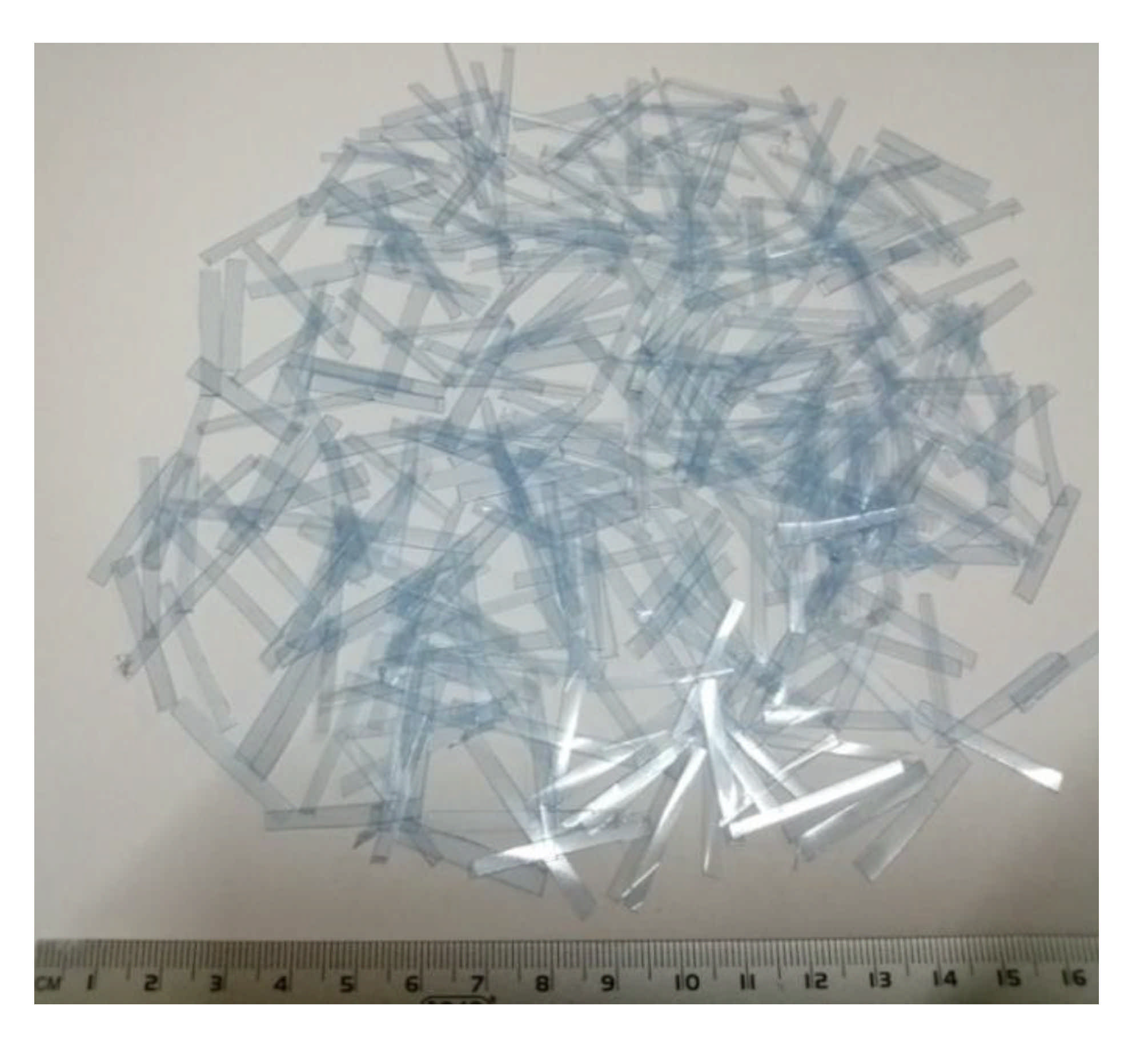


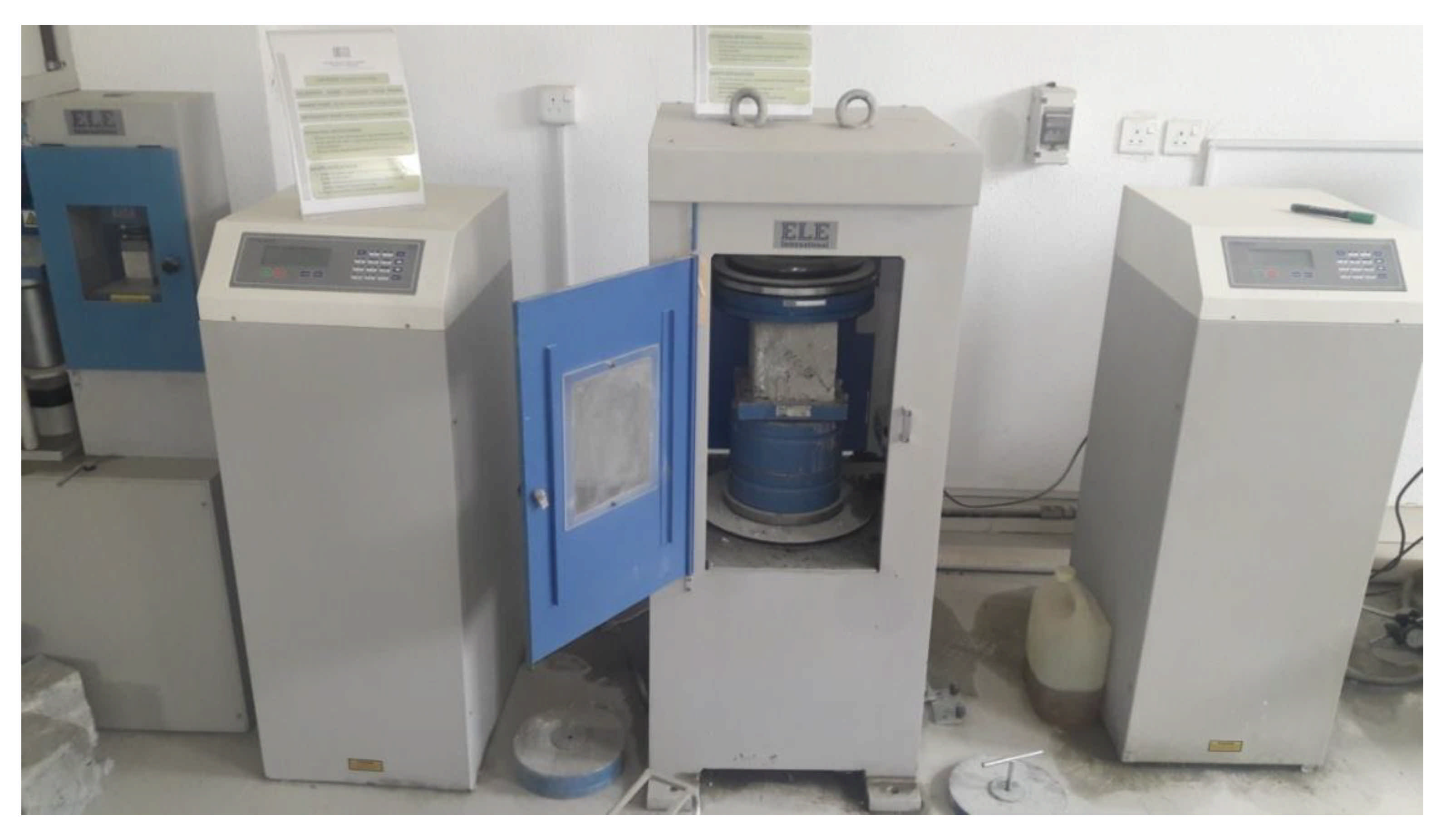
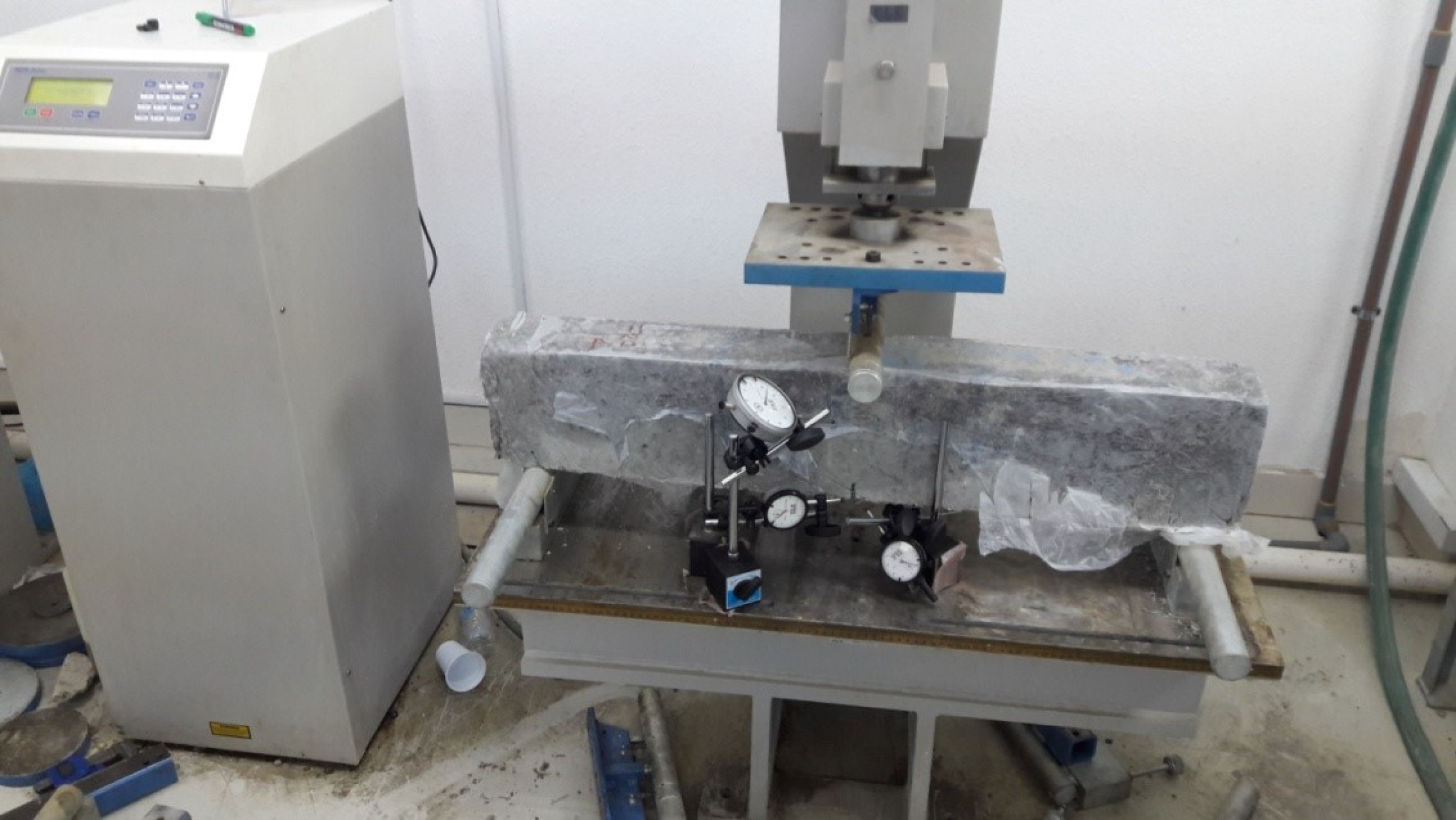

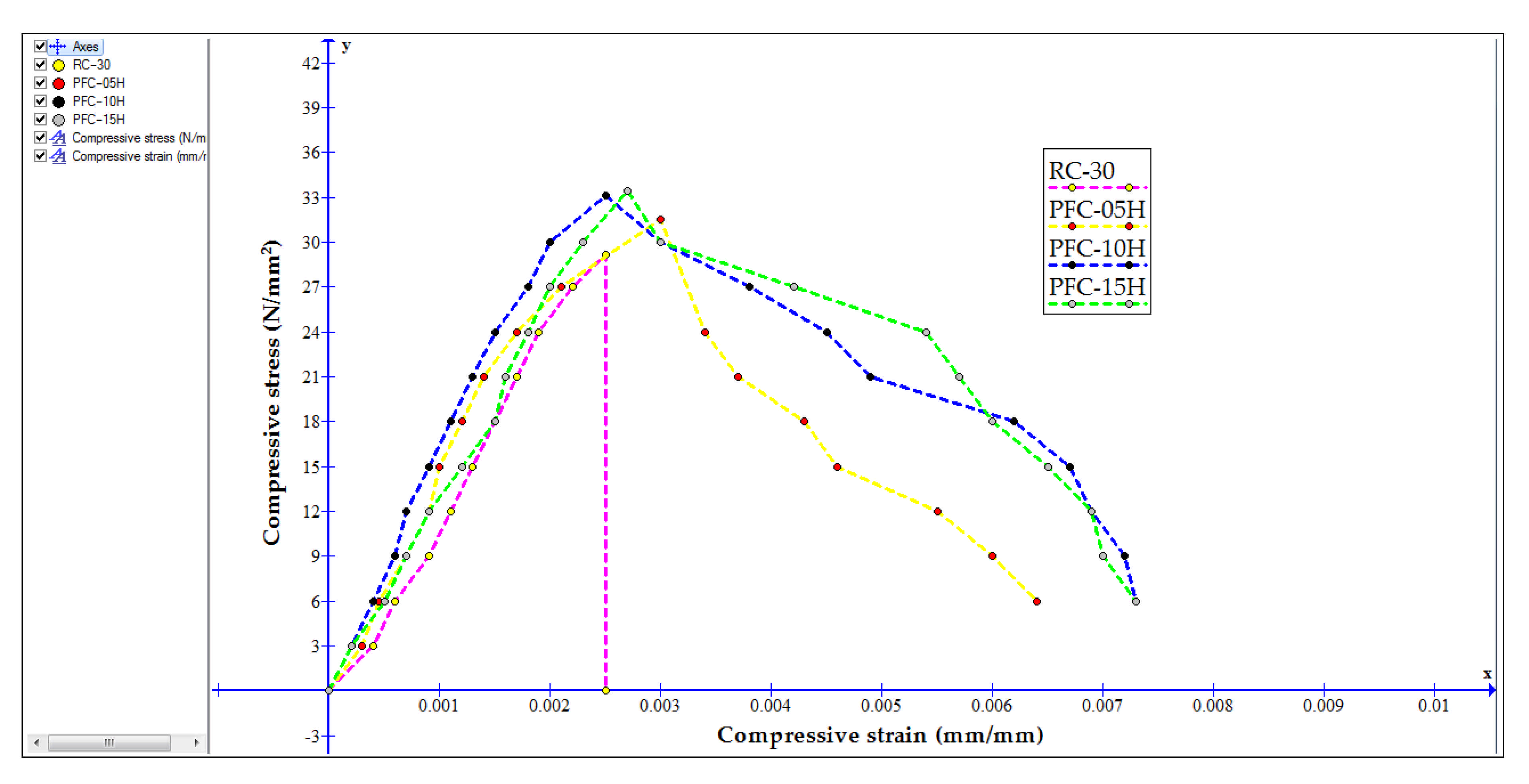

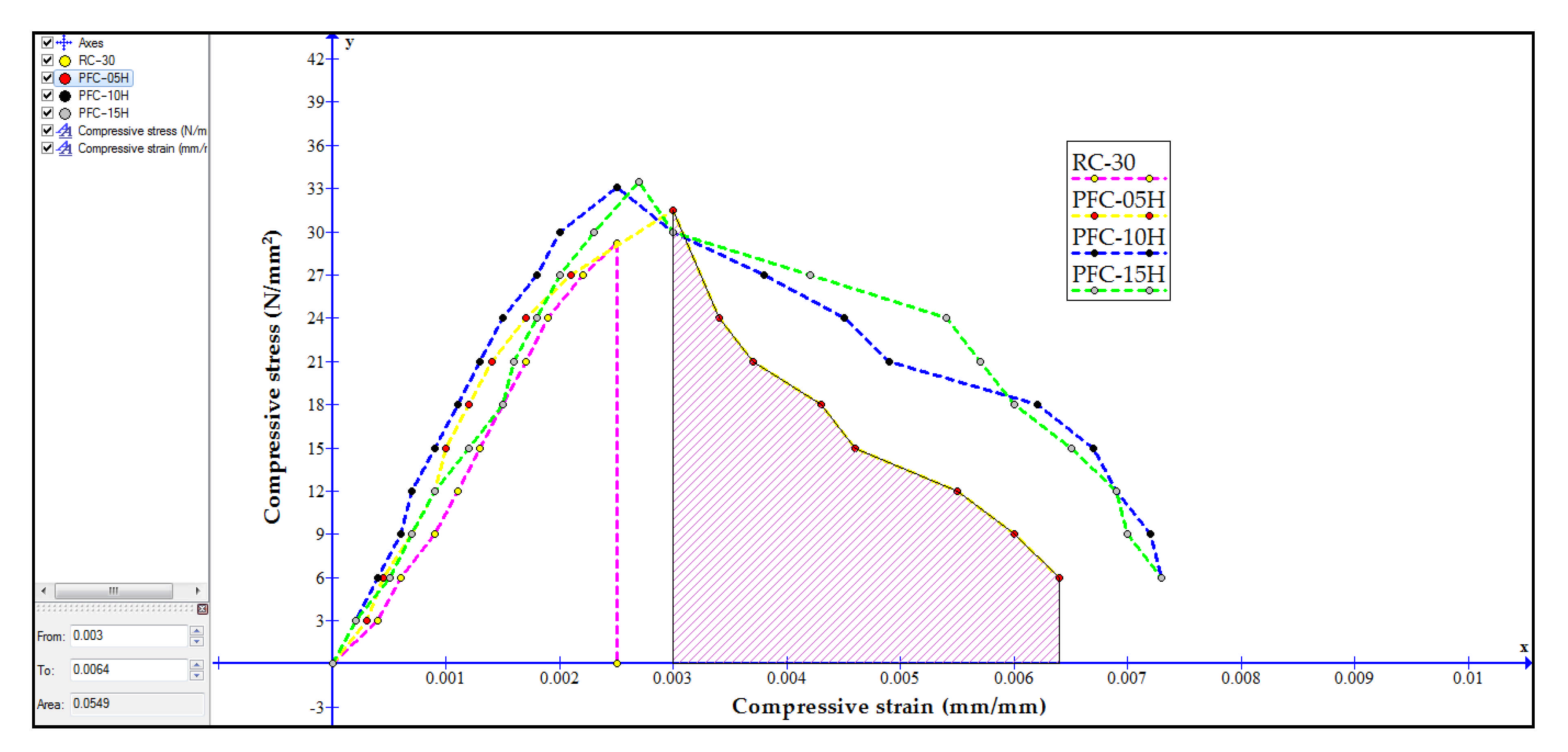
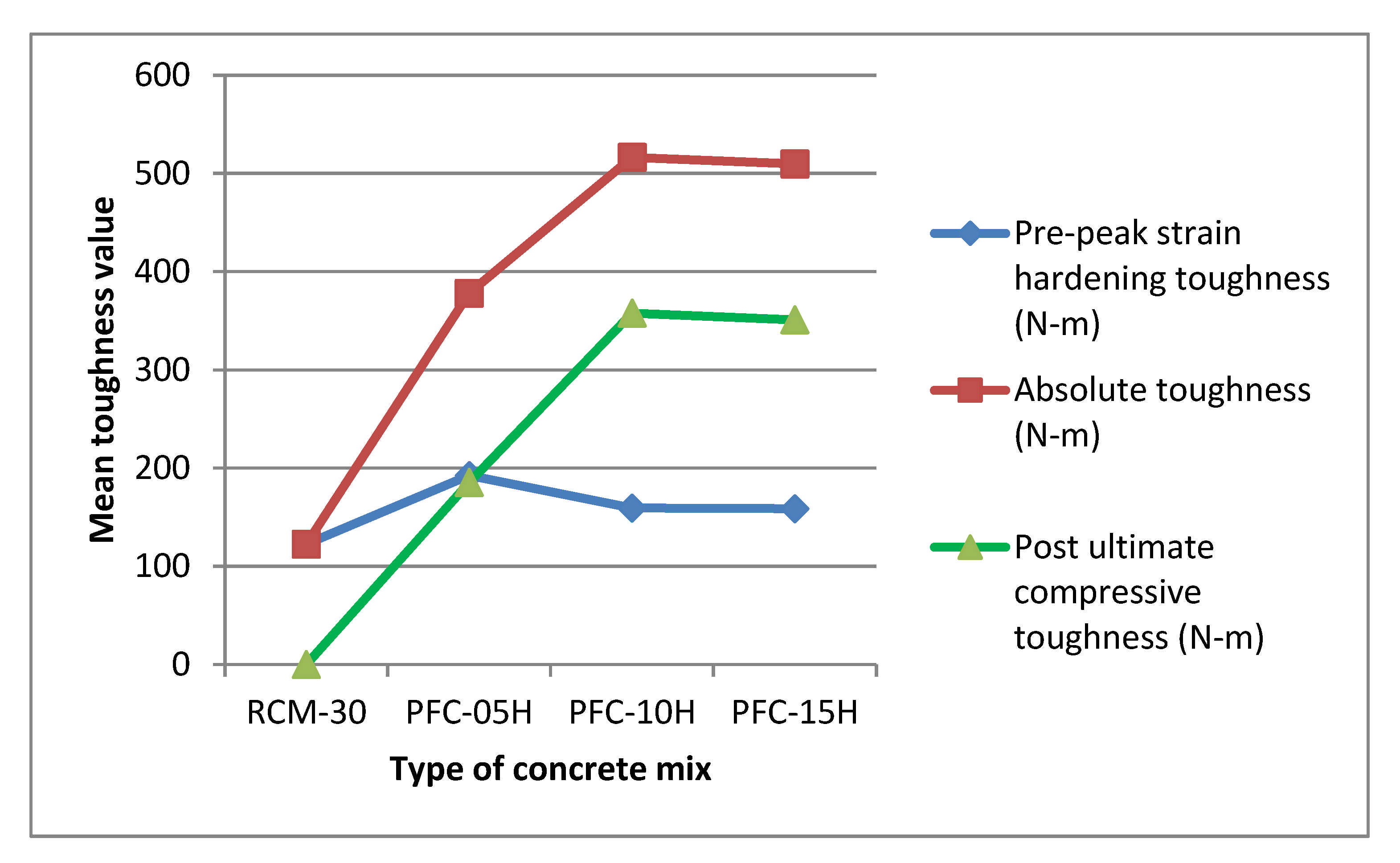



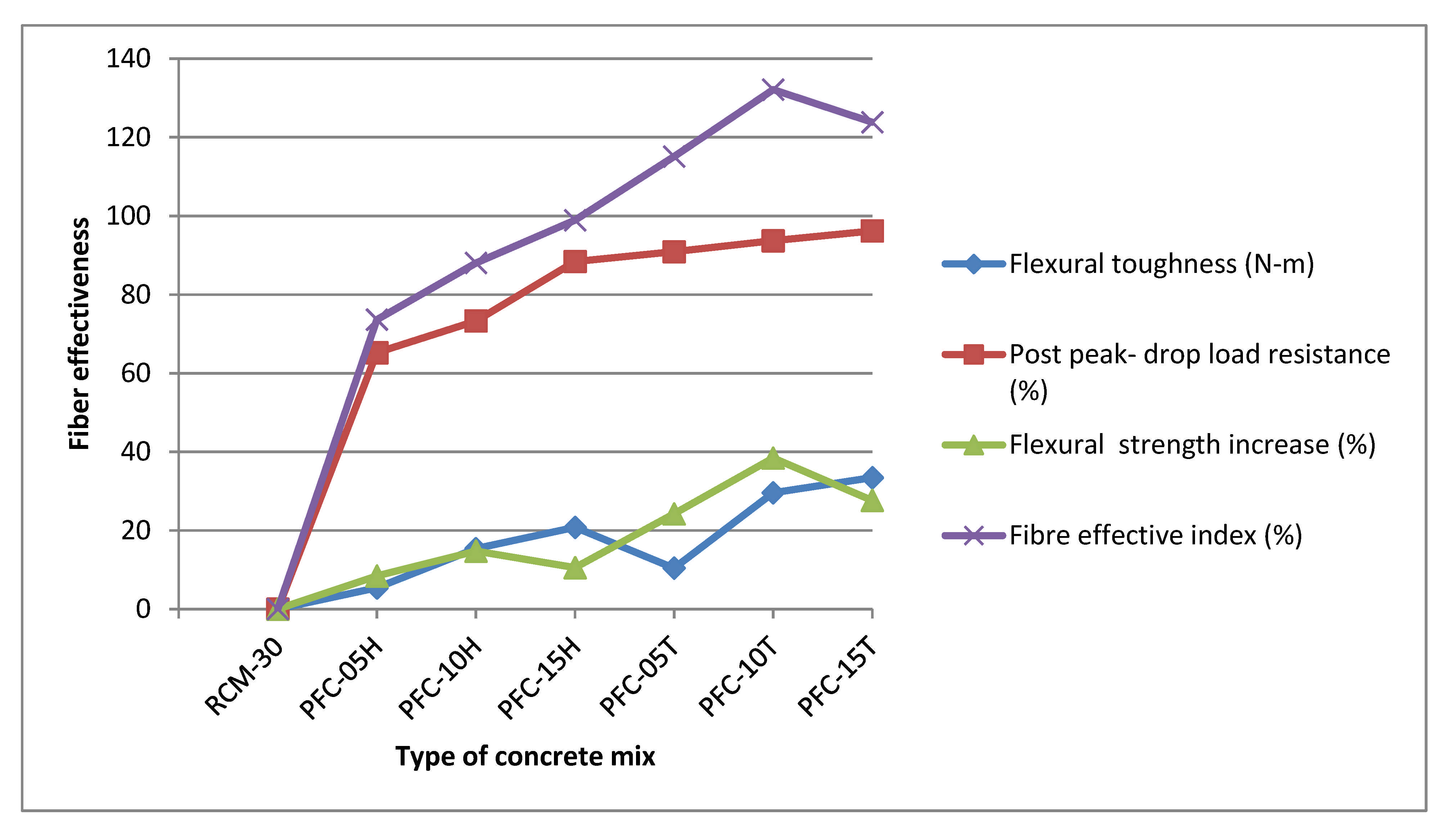
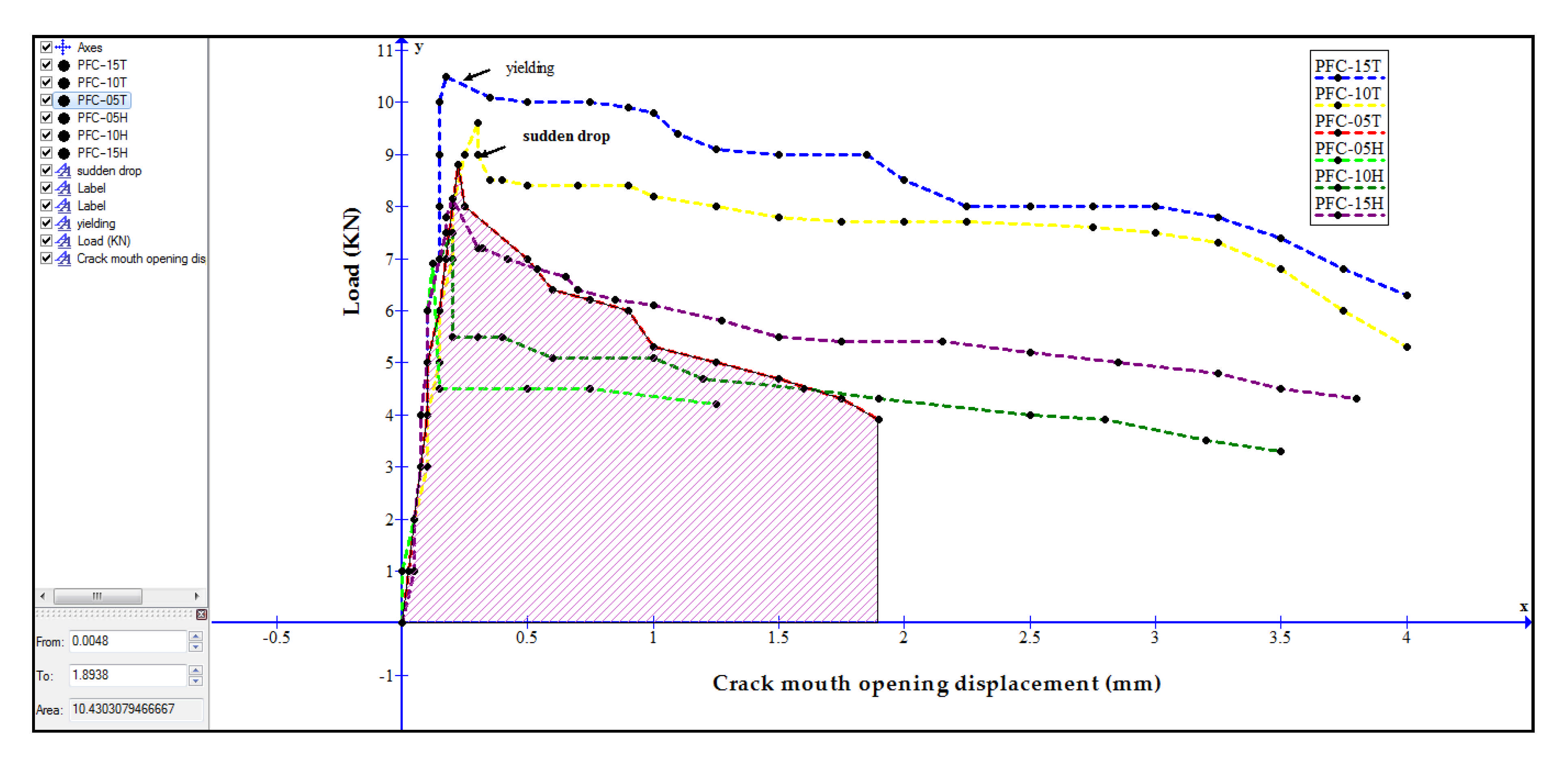
| Properties | Cement | River Sand | Crushed Aggregate |
|---|---|---|---|
| Grade | 43 | 4.75 mm (passing) | 12.5 mm (passing) |
| Specific gravity | 3.12 | 2.45 | 2.61 |
| Average particle size (µm) | 42 | ||
| Fineness modulus | 2.36 | 6.45 | |
| Bulk density (kg/m3) | 3125 | 2205 | 2415 |
| Type of Fiber | Specific Gravity | Average Length (mm) | Average Width (mm) | Aspect Ratio (L/W) | Yield Strength (N/mm2) | Failure Strain (%) |
|---|---|---|---|---|---|---|
| Shredded plastic waste fibers—flat cross section type | 0.92 | 15 | 1.13 | 13.27 | 31.5 | 52 |
| Mix Constituents | Design Concrete—30 N/mm2 |
|---|---|
| Cement (kg/m3) | 342 |
| Sand (kg/m3) | 694 |
| Coarse Aggregate (kg/m3) | 1194 |
| w/c ratio | 0.43 |
| Water (kg/m3) | 175 |
| Superplasticizer (kg/m3) | 1.2% |
| Trial Concrete compressive strength (after 28 days curing) | 22.3 |
| S. No. | Volume Fraction of Plastic Fibers (Vf in %) | Weight of Plastic Fibers Added for 1 m3 of Concrete (kg) |
|---|---|---|
| 1 | 0.05 | 0.46 |
| 2 | 0.10 | 0.92 |
| 3 | 0.15 | 1.38 |
| S. No. | Mix ID | Type of Concrete Mix | Fiber Proportions (Vf in %) |
|---|---|---|---|
| 1. | RCM-30 | Reference concrete | 0 |
| 2. | PFC-05H | Plastic fiber—homogenous | 0.05 |
| 3. | PFC-10H | Plastic fiber—homogenous | 0.10 |
| 4. | PFC-15H | Plastic fiber—homogenous | 0.15 |
| 5. | PFC-05T | Plastic fiber—tension confined | 0.05 |
| 6. | PFC-10T | Plastic fiber—tension confined | 0.10 |
| 7. | PFC-15T | Plastic fiber—tension confined | 0.15 |
| Mix ID | Ultimate Strength (N/mm2) | Residual Strength (N/mm2) | Elastic Modulus (×103 N/mm2) | Pre-Peak Strain Hardening Toughness (N-m) | Absolute Toughness (N-m) | Post Ultimate Toughness (N-m) | Strength Increase (%) | Toughness Increase (%) | Fiber Performance Index (%) |
|---|---|---|---|---|---|---|---|---|---|
| RCM-30 | 30.21 | 2.34 | 26.16 | 122.51 | 122.51 | 0 | - | - | - |
| PFC-05H | 31.53 | 15.61 | 28.05 | 192.38 | 378.02 | 185.29 | 4.37 | 208.56 | 220.26 |
| PFC-10H | 33.12 | 17.23 | 28.78 | 159.3 | 516.38 | 357.75 | 9.63 | 321.5 | 338.95 |
| PFC-15H | 33.25 | 18.16 | 28.91 | 158.63 | 509.63 | 351 | 10.06 | 315.99 | 333.72 |
| Mix ID | First Crack Strength (N/mm2) | Flexural Strength (N/mm2) | Crack Width(mm) | Residual Flexural Strength Capacity (N/mm2) | Flexural Toughness (N-m) | Post Peak-Drop Load Resistance (%) | Flexural Strength Increase (%) | Fiber Effective Index (%) |
|---|---|---|---|---|---|---|---|---|
| RCM-30 | 3.72 | 3.8 | 1.25 | 0 | 0 | 0 | - | - |
| PFC-05H | 3.89 | 4.12 | 1.54 | 2.05 | 5.39 | 65.2 | 8.42 | 73.62 |
| PFC-10H | 4.17 | 4.36 | 1.86 | 3.18 | 15.39 | 73.3 | 14.74 | 88.04 |
| PFC-15H | 3.95 | 4.2 | 1.8 | 3.21 | 20.78 | 88.4 | 10.53 | 98.93 |
| PFC-05T | 4.27 | 4.72 | 2.12 | 2.98 | 10.42 | 90.9 | 24.21 | 115.11 |
| PFC-10T | 4.89 | 5.26 | 2.75 | 4.18 | 29.57 | 93.7 | 38.42 | 132.12 |
| PFC-15T | 4.51 | 4.85 | 3.15 | 4.37 | 33.43 | 96.2 | 27.63 | 123.83 |
Publisher’s Note: MDPI stays neutral with regard to jurisdictional claims in published maps and institutional affiliations. |
© 2021 by the authors. Licensee MDPI, Basel, Switzerland. This article is an open access article distributed under the terms and conditions of the Creative Commons Attribution (CC BY) license (http://creativecommons.org/licenses/by/4.0/).
Share and Cite
Anandan, S.; Alsubih, M. Mechanical Strength Characterization of Plastic Fiber Reinforced Cement Concrete Composites. Appl. Sci. 2021, 11, 852. https://doi.org/10.3390/app11020852
Anandan S, Alsubih M. Mechanical Strength Characterization of Plastic Fiber Reinforced Cement Concrete Composites. Applied Sciences. 2021; 11(2):852. https://doi.org/10.3390/app11020852
Chicago/Turabian StyleAnandan, Sivakumar, and Majed Alsubih. 2021. "Mechanical Strength Characterization of Plastic Fiber Reinforced Cement Concrete Composites" Applied Sciences 11, no. 2: 852. https://doi.org/10.3390/app11020852
APA StyleAnandan, S., & Alsubih, M. (2021). Mechanical Strength Characterization of Plastic Fiber Reinforced Cement Concrete Composites. Applied Sciences, 11(2), 852. https://doi.org/10.3390/app11020852





